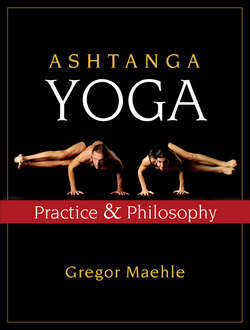Читать книгу Ashtanga Yoga - Gregor Maehle - Страница 103
На сайте Литреса книга снята с продажи.
Vinyasa Two
ОглавлениеIdeally, we enter the posture on one exhalation. Beginners will need to break down the surprisingly complex entry movement into its constituents.
From the middle position, first shorten the stance by four to eight inches, unless you have really long hamstrings. Shortening the stance deducts the difference in distance between the hip joints from the intrinsic stance of Utthita Trikonasana, where the hips are parallel to the mat, to that in Parivrta Trikonasana, where they are square. Otherwise the position of the sacrum will be compromised — it should be parallel the floor — and the position of the spine will be compromised as a result. Students might think keeping the longer stance will produce a greater stretch, a more thrilling sensation, but in fact it impinges on the flow of prana up the sushumna (the central energy channel of the subtle body) and of cerebrospinal fluid in the gross body, which may or may not have some correlation.
Uninterrupted flow in these channels is a goal of yogic practice. If the underlying scientific principles of the practice are not understood, yoga may be of little use.
Having shortened the stance, turn the right foot out 90° and the left foot in approximately 45°. If the left foot is turned in farther than 90°, balance is easily lost, while if the left foot is not turned in sufficiently it is too difficult to square the hips — or if they are squared excess strain is placed on the left knee, since the tibia rotates outwardly and the femur rotates medially, following the movement of the pelvis. Now pin the right hip back by grounding the base of the right big toe, and draw the left hip forward by grounding the outside of the left foot, until the hips are square.
ANATOMICAL FOCUS
Spinal Movement
The lumbar spine is structurally unsuitable for twisting due to the orientation of its facet joints (L1–L5). Although twisting movements are limited in the lumbar spine, it has a great range of movement in flexion and extension (forward- and backbending respectively). In comparison, the orientation of the facet joints in the thoracic spine (T1–T11) allows ample rotation but limited extension. Extension is also limited here due to the direct attachment of the ribs onto the vertebral body and its transverse processes (twelve pairs of ribs attach to the twelve thoracic vertebrae).
With the left hand, reach far forward beyond your right foot. Exhaling, lower the hand and place it on the outside edge of the right foot, with the little finger next to the little toe. The fingers are spread and point in the same direction as the toes. Maintain the lift of the heart by not flexing but rather continuing to lengthen the trunk. Draw your shoulder blades down the back and bring your heart through from between the shoulders. If this is not possible with the hand on the floor, place it on your foot or shin. The left hand pushes the floor away. The right fingertips reach up to the ceiling, where the gaze is focused. Beginners may gaze down to the foot if looking up makes them lose their balance.
It is important to keep both hip joints at an even distance from the floor. To achieve this, avoid leaning into the front (right) foot. Instead, pin the right hip back by grounding the roots of the toes of the right foot and engaging the abductors of the hip on the right side. These actions prevent the left hip from sagging.
